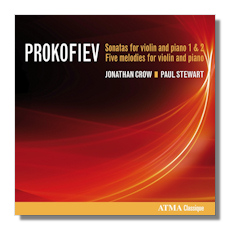
The Internet's Premier Classical Music Source
Related Links
- Prokofieff Reviews
- Latest Reviews
- More Reviews
-
By Composer
-
Collections
DVD & Blu-ray
Books
Concert Reviews
Articles/Interviews
Software
Audio
Search Amazon
Recommended Links
Site News
 CD Review
CD Review
Serge Prokofieff

Works for Violin
- Sonata for Violin & Piano #1 in F minor, Op. 80
- Sonata for Violin & Piano #2 in D Major, Op. 94bis
- Five Melodies for Violin & Piano, Op. 35bis
Jonathan Crow, violin
Paul Stewart, piano
Atma Classique ACD2-2535 65min
Canadian violinist Jonathan Crow is the concertmaster with the Toronto Symphony Orchestra, a post he has held since 2011. From 2002-06 he had served as concertmaster of the Montreal Symphony Orchestra. Fellow Canadian artist Paul Stewart is a concert pianist who has appeared in recitals in such venues as Carnegie Hall and as soloist with major orchestras throughout the world. It can be said these two have impressive credentials, but neither performer is well known outside of Canada though they are immensely talented and show a strong affinity for the music of Prokofiev.
Crow plays with an imposing, full-bodied tone and tends to approach these works in a fairly straightforward manner that favors the muscular, assertive side of these scores. It works well in the dark and profound F minor Sonata, not least because pianist Paul Stewart seconds the rather potent treatment, realizing his role is as important as Crow's. But all is not big or crushing in sonority: the first movement closing, with those scurrying high notes on the violin, truly comes across as a ghostly but delicate wind whistling through the graveyard. The second movement is powerful and ferocious here, as it should be, and the third is songful and dreamy, but also filled with regret: you're made strongly aware of that last trait by Crow's haunting phrasing of the mesmerizing three-note theme in the middle section. The finale begins with great energy but before long you're aware of the demons haunting this movement. Crow's sul ponticello effects are nicely done here and the ending is shattering in the collapse and subsequent catastrophe and sadness that follow. A brilliant performance!
If this were the only thing on the recording, I would still give a strong recommendation – but there's considerably more. The duo's performance of the sunny Op. 94bis is appropriately light and chipper. This work is a transcription of the Sonata for Flute and Piano, Op. 94. At one time it was more popular in the violin/piano version than in its original, though that status has changed. Violinists have loved the work, but now the flutists have taken to it in greater numbers. Crow and Stewart offer an excellent account of this sonata as well, finding a little more substance in it than in most performances. Their rendition of the third movement is utterly splendid for their lush phrasing of those two ravishing themes.
The Five Melodies for Violin and Piano is also a transcription: originally it was conceived as a vocalise for voice and piano, but it is rarely heard in that version today. The work is well suited to the violin largely because of the music's plentiful lyricism in the higher ranges. Here Crow and Stewart once again are finely attuned to Prokofiev's songful style. The second and third of the five pieces come across especially well, the lyricism often exuding a meltingly beautiful character or a haunting sense of mystery.
The instruments are closely miked and the sound is thus quite powerful but always clear. The competition in these works is fierce: Argerich and Kremer (DG 431803-2), Bielovand Tchetuev (Naxos 8.555904), Gluzman and Yoffe (BIS SACD-2032), Gil Shaham and Orli Shaham (Canary Classics CC02), and Oliveira and Koenig (Artek AR-0029-2). There are a few more I could mention (two by Oistrakh, for example), but suffice it to say this repertory has been well treated on record, and this new entry on Atma Classique goes to or near the top of the list. Highly recommended!
Copyright © 2014, Robert Cummings




















